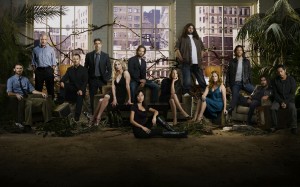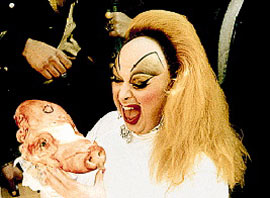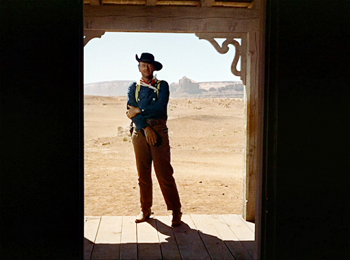
.
standard launching point for many a story, or a segué into a flashback, is some variation on the phrase “Let’s start at the beginning.” But today we’re going to begin at the end.
The ending of a movie is arguably the most important part. It’s the moment when everything that’s come before is gathered, resolved, and handed over to the audience, a complete package for you to take with you as you leave the theater. My favorite kind of ending is the kind where the package is left a little open, or at least unwrapped, for me to ponder and interpret for myself; movies that leave you with a question, rather than an answer. But a lot of films attempt to gather all the narrative threads spun out in the telling and tie them up in a neat bow, handing the audience something that is complete and whole, with no further thought necessary.
The problem with this kind of ending is that it’s entirely artificial: it has no counterpart in real life. Real life has no endings. Well, I take that back—at least long enough to define my terms. When I say “life,” in this context, I mean the zoomed-out view: the collective experience of humanity on this planet. You could zoom out even further, to include all life, but for now let’s limit ourselves to human experience. From that viewpoint, endings are a human invention: a literary device. Stuff happened before you got here, and will continue after you’re gone.
Zooming in now, life is actually full of endings. In fact, as a species we seem to have an obsession with the end of things. A thing’s end is often its most salient feature, the focal point of how we think about it. Millions of people tune in every week to watch aspiring young singers struggle toward an anticipated endpoint: when there is one left standing, the season—which progresses along a path strewn with endings, as each contestant is eliminated—will end. Most of us  have come across the wild-eyed streetcorner prophet whose entire understanding of the universe he lives in is embodied in his idea of its end. We debate eternally which should take precedence in the field of human endeavor: means or end.
have come across the wild-eyed streetcorner prophet whose entire understanding of the universe he lives in is embodied in his idea of its end. We debate eternally which should take precedence in the field of human endeavor: means or end.
We obsess on split ends. Dead end. End times. End game. We define the ground we stand on by where it ends, where the ocean meets the shore: land’s end. The entire nation, as politically divided as it can be, can come together in a cohesive swell of anticipation and passion for the end of a television series, a series whose entire reason for being rested upon this anticipation of what would be revealed at the end. Our very nature as a nation—as a species!—changed with the end of WWII and the atomic bomb: suddenly life on Earth itself had a conceivable end.
 The role of traditional media has always been to break life up into manageable chunks; to impose on the messy realities of life a narrative with a beginning, middle, and end. The animating principle of books, movies, even newspapers, is the story: a narrative whole.
The role of traditional media has always been to break life up into manageable chunks; to impose on the messy realities of life a narrative with a beginning, middle, and end. The animating principle of books, movies, even newspapers, is the story: a narrative whole.
Social media explodes the myth of the applied ending and provides us with a new model: a narrative that continues even when we’re finished with it. With facebook, twitter, and the various other organs of social media, we come upon stories already in progress. We can even affect these narratives, if we do more than observe and actually participate. With every like and follow we’re asserting ourselves as storytellers, and not just the vast, faceless audience sitting in the dark.
 So, more and more, our media experience is like stepping into a running stream, rather than consuming discrete narrative packages. Will social media bring about the end of the ending? It will almost certainly, at least, affect our cultural, universal expectation of the pat conclusion to every story we are told, by movies or books or news media. Consider computer games: traditionally, the route a player took to the endpoint of a game varied from player to player, as player participation affected the “narrative” of the game. But the finish line was the same for everyone. Currently, however, there’s an increasing trend toward open-ended games, where player participation affects not just the journey, but the destination.
So, more and more, our media experience is like stepping into a running stream, rather than consuming discrete narrative packages. Will social media bring about the end of the ending? It will almost certainly, at least, affect our cultural, universal expectation of the pat conclusion to every story we are told, by movies or books or news media. Consider computer games: traditionally, the route a player took to the endpoint of a game varied from player to player, as player participation affected the “narrative” of the game. But the finish line was the same for everyone. Currently, however, there’s an increasing trend toward open-ended games, where player participation affects not just the journey, but the destination.

Because the narrative ending is little more than a literary trope, with no antecedent in real life, it’s the most difficult thing for a filmmaker to get right.[ref]The great German filmmaker Douglas Sirk left Hollywood, he told one interviewer, because of what he called the “tyranny” of the happy ending: “These happy endings all express the weak and sly promise that the world is not rotten and out of joint but meaningful and ultimately in excellent condition.”[/ref] So many movies get so close, hit all the right notes, and then blow the whole production with a bad ending. (Yes, Saving Private Ryan, I’m looking at you.)
If the art of the ending is a fading art, let us consider these masterpieces of the form. My list of great endings can run to dozens of titles, but here are a handful of favorites. (Needless to say, beyond this point there be spoilers.)

The most powerful ending in cinema remains for me that of Charlie Chaplin’s masterpiece City Lights (1931), when the Blind Girl recognizes the Little Tramp as the “rich” man who paid for the operation that restored her sight simply by touching his hand . No matter how many times I watch this movie, that moment, when we see her realization in her face, punches me in the gut. Goose-pimples, neck hairs, tears—every single time.
Just as timeless, and just as powerful, is the ending of John Ford’s The Searchers (1956). John Wayne plays Ethan Edwards, a cynical Confederate veteran for whom the Civil War will never be over. In the final scene, he is returning from a quest of several years’ duration. He’s been searching for his niece, who was taken as a child by raiding Indians. Ethan’s general misanthropy finds expression mostly in an unbending hatred of Native Americans, and so he considers his niece to be unsalvageable: she’s no longer white, in his eyes, and thus he sees as his journey’s end the duty he has to kill her. But the reality of that moment takes him by surprise: he raises her in his arms in preparation, we imagine, for dashing her head on the stony ground, but lowers her to his breast in an embrace instead. And so he returns her to the arms of her family, who fold around her in a protective welcoming, shutting Ethan out. The hatred that fueled his search makes him unfit for human society, and so he turns to walk away. He continues walking as the screen fades to black, and the credits roll. One of the most iconic scenes in American movies, and one which Christopher Nolan pays homage to in the ending of The Dark Knight, as Batman recedes into the night: the hero who’s hunted even as he watches and protects.
![]()
In Jim Jarmusch’s postmodern Western Dead Man, Johnny Depp plays a man named William Blake who has traveled across the entire breadth of the US by train, from the East Coast to the West, sitting upright for the duration of a journey which likely took most of a week. He receives a bullet wound so close to his heart that there is no possible remedy, and his journey toward a new life acquires a new destination: that of his own death. A new friend, a Native American named Nobody, helps him on his way, and as a final act of friendship prepares a funereal boat for Blake and pushes him out into the ocean, to complete his westward journey in the same way the sun does every day.
![]()
There are many more films that deserve a spot on this list: Night of the Living Dead, The Birds, Some Like It Hot, The Godfather—a seemingly endless list.
NOTE: an earlier version of this article appeared at blog.indieflix.com





